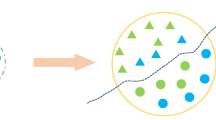Abstract
This paper presents the domain generalization methods Multi-Domain Transfer Component Analysis (Multi-TCA) and Multi-Domain Semi-Supervised Transfer Component Analysis (Multi-SSTCA) which are extensions of the domain adaptation method Transfer Component Analysis to multiple domains. Multi-TCA learns a shared subspace by minimizing the dissimilarities across domains, while maximally preserving the data variance. The proposed methods are compared to other state-of-the-art methods on three public datasets and on a real-world case study on climate control in residential buildings. Experimental results demonstrate that Multi-TCA and Multi-SSTCA can improve predictive performance on previously unseen domains. We perform sensitivity analysis on model parameters and evaluate different kernel distances, which facilitate further improvements in predictive performance.

Similar content being viewed by others
References
Belkin M (2006) Manifold regularization: a geometric framework for learning from labeled and unlabeled examples. J Mach Learn Res 7:2399–2434
Blanchard G, Lee G, Scott C (2011) Generalizing from several related classification tasks to a new unlabeled sample. In: NIPS, pp 2178–2186
Brinkman R, Gasparetto M, Lee SJ, Ribickas A, Perkins J, Janssen W, Smiley R, Smith C (2007) High-content flow cytometry and temporal data analysis for defining a cellular signature of graft-versus-host disease. Biol Blood Marrow Transplant 13(6):691–700
Ghifary M, Bastiaan Kleijn W, Zhang M, Balduzzi D (2015) Domain generalization for object recognition with multi-task autoencoders. In: Proceedings of the IEEE international conference on computer vision, pp 2551–2559
Gong B, Grauman K, Sha F (2013) Connecting the dots with landmarks: Discriminatively learning domain-invariant features for unsupervised domain adaptation. In: ICML, pp 222–230
Gretton A, Borgwardt K, Rasch M, Schölkopf B, Smola A (2006) A kernel method for the two-sample-problem. In: NIPS, pp 513–520
Gretton A, Bousquet O, Smola A, Schölkopf B (2005) Measuring statistical dependence with Hilbert-Schmidt norms. In: ALT, pp 63–77
Grubinger T, Birlutiu A, Schöner H, Natschläger T, Heskes T (2015) Domain generalization based on transfer component analysis. In: Advances in computational intelligence. Springer, pp 325–334
Ionescu RT, Popescu M (2015) PQ kernel: a rank correlation kernel for visual word histograms. Pattern Recognit Lett 55:51–57
Little M, McSharry P, Roberts S, Costello D, Moroz I (2007) Moroz I (2007) Exploiting nonlinear recurrence and fractal scaling properties for voice disorder detection. BioMed Eng OnLine 6(1):23
Muandet K, Balduzzi D, Schölkopf B (2013) Domain generalization via invariant feature representation. In: Proceedings of the 30th international conference on machhine learning, pp 10–18
Müller K, Mika S, Rätsch G, Tsuda K, Schölkopf B (2001) An introduction to kernel-based learning algorithms. IEEE Trans Neural Netw 12(2):181–201
Pan S, Tsang I, Kwok J, Yang Q (2011) Domain adaptation via transfer component analysis. IEEE Trans Neural Netw 22(2):199–210
Pan S, Yang Q (2010) A survey on transfer learning. IEEE Trans Knowl Data Eng 22(10):1345–1359
Persello C, Bruzzone L (2014) Relevant and invariant feature selection of hyperspectral images for domain generalization. In: International geoscience and remote sensing symposium (IGARSS), IEEE. pp 3562–3565
Schölkopf B, Smola A, Müller K (1999) Kernel principal component analysis. In: International Conference on Artificial Neural Networks, pp 583–588
Sun H, Liu S, Zhou S (2016) Discriminative subspace alignment for unsupervised visual domain adaptation. In: NEPL, pp 1–15
Sun S, Shi H (2013) Bayesian multi-source domain adaptation. In: International conference on machine learning and cybernetics, IEEE, vol 1, pp 24–28
Sun S, Shi H, Wu Y (2015) A survey of multi-source domain adaptation. Inf Fusion 24:84–92
Vedaldi A, Zisserman A (2012) Efficient additive kernels via explicit feature maps. IEEE Trans Pattern Anal Mach Intell 34(3):480–492
Xu Z, Li W, Niu L, Xu D (2014) Exploiting low-rank structure from latent domains for domain generalization. In: Computer vision—ECCV 2014—13th European conference, pp 628–643. doi:10.1007/978-3-319-10578-9_41
Xu Z, Sun S (2012) Multi-source transfer learning with multi-view adaboost. In: International conference on neural information processing systems, Springer. pp 332–339
Xue Y, Liao X, Carin L, Krishnapuram B (2007) Multitask learning for classication with Dirichlet process priors. J Mach Learn Res 35(8):35–63
Zhang H, Ji H, Wang X (2012) Transfer learning from unlabeled data via neural networks. NEPL 36(2):173–187
Author information
Authors and Affiliations
Corresponding author
Additional information
The research reported in this paper has been supported by the Austrian Ministry for Transport, Innovation and Technology, the Federal Ministry of Science, Research and Economy, and the Province of Upper Austria in the frame of the COMET center SCCH.
Rights and permissions
About this article
Cite this article
Grubinger, T., Birlutiu, A., Schöner, H. et al. Multi-Domain Transfer Component Analysis for Domain Generalization. Neural Process Lett 46, 845–855 (2017). https://doi.org/10.1007/s11063-017-9612-8
Published:
Issue Date:
DOI: https://doi.org/10.1007/s11063-017-9612-8




